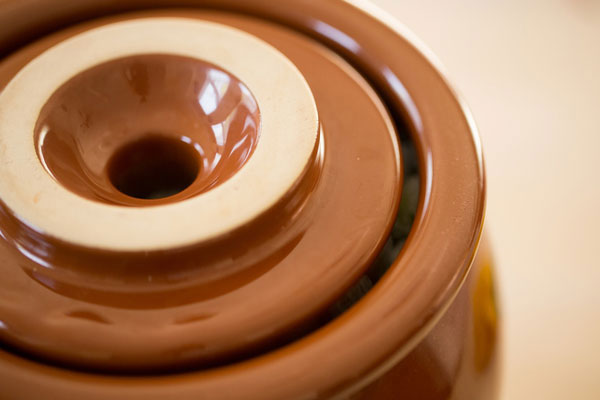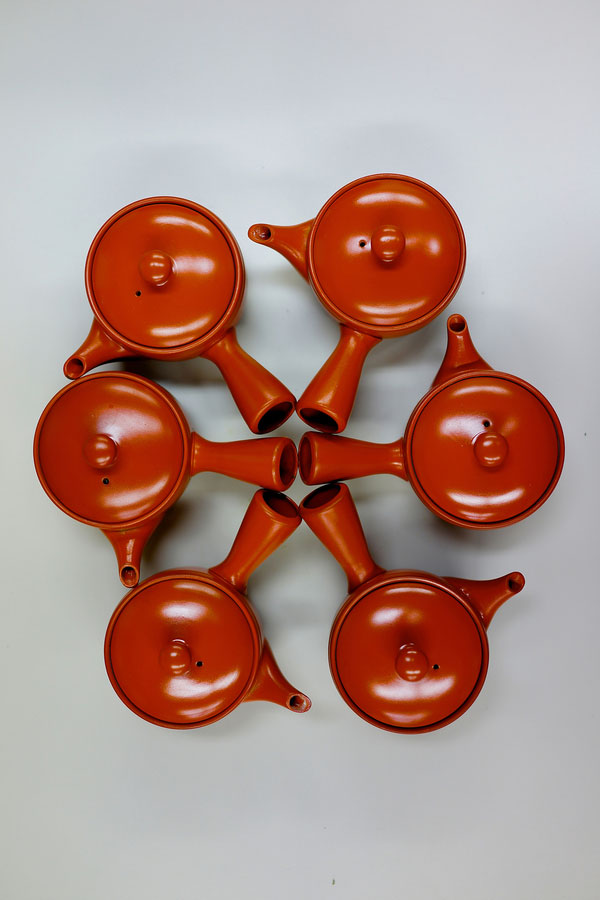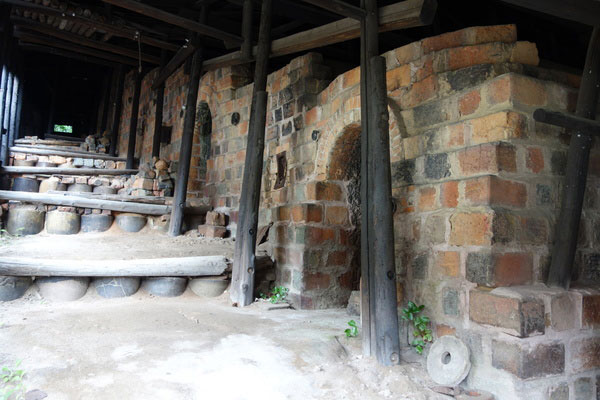
- Ceramic
- Aichi
Tokoname ware Tokoname yaki
One of Japan's Six Ancient Kilns
Loved throughout Japan for over 1000 years
Description
What is Tokoname ware ?
Tokoname ware (Tokoname yaki in Japanese) is a form of ceramic pottery that is produced in the area around the city of Tokoname in Aichi prefecture. This traditional craft comes from one of the Six Ancient Kilns of Japan. Along with Bizen, Tamba, Echizen, Seto, and Shigaraki, Tokoname is one of the most outstanding Japanese kilns with traditions that remain even today. Tokoname ware was created in the latter part of the Heian period (794-1185), making it an incredibly ancient form of porcelain. It uses potter's clay collected from the Chita peninsula, where Tokoname is located, which contains a large amount of iron. Its unique color is caused by the iron which makes the clay turn red after baking. This is called shudei (the unglazed reddish brown pottery). Various types of products like teacups and flowerpots have been produced, but small iron teapots are especially favored today because the iron is said to smoothen the bitterness and astringency of tea. There are many kilns on the hills of the Chita Peninsula in Aichi Prefecture, and since ancient times artisans have been working in them with traditional techniques. These artisans, who produce high quality products, have inherited their skills from a 1,000 year old history. They are still using traditional techniques such as hand twisted casting which has been used since the Heian period. Other techniques are yoriko tsukuri which is used when producing large items such as wide jars, pressing which is used when producing bonsai pots, and molding with an electric potter's wheel.
History

The origin of Tokoname ware goes back to the end of the Heian period (794-1185). It is said that at that time Tokoname had approximately 3,000 ascending kilns called anagama, formed by digging holes in the hillside. Tokoname was the biggest pottery producing area even among the Six Ancient Kilns of Japan. Tokoname ware products have changed quite a bit over the course of history as the products made during the Heian period are just a prototype of today's Tokoname ware. The main products were large containers like bottles and pots, but also small items such as teaware for tea ceremonies and vessels for flower arrangement as well as daily necessities of the Edo period (1603-1868). The reddish brown pottery, shudei tea utensils were produced from the end of the Edo period to the early Meiji period (1868-1912). The most popular small teapots of Tokoname ware were also first produced during the Edo period. During the Meiji period, modernization and influence from other countries changed the life style of Japanese people. As railroads started running, strong raw materials were in demand for waterway construction work between the lines, and demand for tightly packed Tokoname ware clay pipes increased accordingly. During the Taisho period (1912-1926), architectural Tokoname ceramics were in high demand and Tokoname ware building tiles became widespread. The techniques of Tokoname ware have been preserved over the generations and are nationally registered as traditional crafts.
General Production Process

- 1. Kneading the clay
Since there are various Tokoname ware products, this explanation covers only the production process of shudei small teapots.
The first step is to extract the finer bits of clay from the collected clay. The selected clay is kneaded thoroughly until it reaches a muddy liquid state.
- 2. Work on the potter's wheel Small teapots are cast one part at a time: the body, the lid, the handle and the spout. First, the body is placed on the potter's wheel and rotated. Little by little, using a spatula or a similar implement, the form is smoothed. Once the body is finished, the artisan moves onto other parts which will be rotated on the potter's wheel as well. When the pieces are smoothed, they are dried with care to ensure that each piece is dried to the same extent.
- 3. Completing each part
As the drying progresses and the pieces become hard, unnecessary parts are shaved down to make the piece neat.
Minor adjustments are made in order to ensure the body and lid perfectly match.
The way to produce a high quality product is to complete the pieces during this step, before the product has completely dried, with as much care and detail as possible. - 4. Assembly
The spout and handle are attached to the body. Circular openings are made in the body using a special tool, and the other parts are then joined.
The finished state will be affected if these parts do not fit together perfectly so this process requires high skills.
The state of drying and hardness must also be carefully checked during this step. - 5. Drying
Cracks or deformations may occur during this step if the artisan is not careful. This is an important process to complete before the final step.
The pieces are dried slowly over time. The state of drying will be altered with even slight changes of temperature or humidity, etc., so the pieces have adjustments made in order to dry uniformly. - 6. Polishing of unglazed pottery
The polishing of unglazed pottery is a step that involves polishing with a cloth or other implements until a gloss appears on the surface.
After polishing the piece many times, a beautiful gloss is produced. - 7. Engraving This process involves patterning the pieces before placing them in the kiln. This is when the craftsmanship of the artisan stands out the most, as various engravings are done by hand with a seal carving knife.
- 8. Firing Small teapots that have been dried and engraved are loaded inside the kiln. Once loaded, the kiln door is closed and the pieces are fired for around 12 to 18 hours at a temperature of approximately 1100℃ (2012℉). In the past, it was necessary to manually adjust the kiln temperature in order to maintain a stable temperature, but today it is controlled by computer. The fire color changes drastically depending on this temperature adjustment. After the firing, the pieces are removed from the kiln after about a day. The small teapots shrink to about 80% of their pre-firing size.
- 9. Inking and rinsing In this process the small teapots are polished again. Then, the outlines of the patterns engraved on the small teapots are boldly emphasized by applying ink to the engraved parts. Once the ink is washed away, the pattern stands out beautifully.
- 10. Finishing
One of Tokoname ware's selling points is its excellent airtight quality, so the lid and body are carefully checked for any gaps, reshaped and polished in order to be made to fit together perfectly.
By producing one piece at a time, the lids and body fit together so perfectly that slight gaps will be seen when paired with different lids. The shudei small teapot is now complete.
Where to Buy & More Information
Aichi Prefectural Ceramic Museum

-
Address
-
Tel.+81-561-84-7474
-
ClosedMondays (open if Monday is holiday and closed the next day) and December 26 to January 4
-
Business Hours9:30am to 4:30pm (Jul. 1 - Oct. 2: 9:30am to 5pm)
-
Website
See more Ceramic
- Imari ware/Arita ware
- Hasami ware
- Kutani ware
- Mashiko ware
- Shigaraki ware
- Bizen ware
- Hagi ware
- Koishiwara ware
- Mino ware
- Tobe ware
- Tokoname ware
- Karatsu ware
- Kasama ware
- Satsuma ware
- Iga ware
- Mikawachi ware
- Agano ware
- Otani ware
- Obori-soma ware
- Tsuboya ware
- Aizu-hongo ware
- Shodai ware
- Echizen ware
- Akazu ware
- Tamba-tachikui ware
- Yokkaichi-banko ware
- Izushi ware
- Kyo ware/Kiyomizu ware
- Iwami ware
- Amakusa ceramics
- Seto-sometsuke ware
- Sanshu Onigawara Crafts
See items made in Aichi
- Tokoname ware
- Akazu ware
- Toyohashi brushes
- Nagoya textiles
- Nagoya Buddhist altar
- Owari Cloisonné
- Arimatsu tie-dyeing
- Mikawa Buddhist altar
- Seto-sometsuke ware
- Nagoya kimono-dyeing
- Nagoya traditional paulownia chest
- Okazaki stonemasonry
- Nagoya Sekku Kazari
- Owari Buddhist altar equipment
- Sanshu Onigawara Crafts































































































































































































































































































